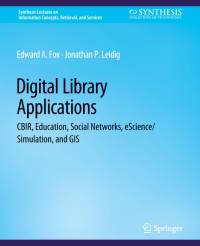Über Digital Libraries Applications
Digital libraries (DLs) have evolved since their launch in 1991 into an important type of information system, with widespread application. This volume advances that trend further by describing new research and development in the DL field that builds upon the 5S (Societies, Scenarios, Spaces, Structures, Streams) framework, which is discussed in three other DL volumes in this series.While the 5S framework may be used to describe many types of information systems, and is likely to have even broader utility and appeal, we focus here on digital libraries. Drawing upon six (Akbar, Kozievitch, Leidig, Li, Murthy, Park) completed and two (Chen, Fouh) in-process dissertations, as well as the efforts of collaborating researchers, and scores of related publications, presentations, tutorials, and reports, this book demonstrates the applicability of 5S in five digital library application areas, that also have importance in the context of the WWW, Web 2.0, and innovative information systems. By integrating surveys of the state-of-the-art, newresearch, connections with formalization, case studies, and exercises/projects, this book can serve as a textbook for those interested in computing, information, and/or library science. Chapter 1 focuses on images, explaining how they connect with information retrieval, in the context of CBIR systems. Chapter 2 gives two case studies of DLs used in education, which is one of the most common applications of digital libraries. Chapter 3 covers social networks, which are at the heart of work onWeb 2.0, explaining the construction and use of deduced graphs, that can enhance retrieval and recommendation. Chapter 4 demonstrates the value of DLs in eScience, focusing, in particular, on cyber-infrastructure for simulation. Chapter 5 surveys geospatial information in DLs, with a case study on geocoding. Given this rich content, we trust that any interested in digital libraries, or in related systems, will find this volume to be motivating, intellectually satisfying, and useful. We hope it will help move digital libraries forward into a science as well as a practice. We hope it will help build community that will address the needs of the next generation of DLs.
Mehr anzeigen

